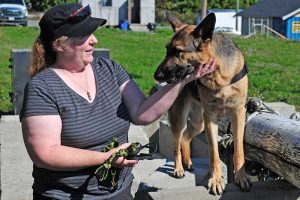A unique team set to save lives
By Lookout on Sep 16, 2013 with Comments 0
When Angela Lavergne and dog Moxxii go for a walk, it’s not trails and lakes they head for, but piles of rubble and dense tree lines.
Lavergne and Moxxii are urban search and rescue volunteers and have been training in tracking and searching together for almost two years.
Lavergne adopted Moxxii as a puppy, and within a year she realized the rambunctious German Sheppard was the “worst pet ever.”
“I can’t tell you how many pairs of shoes, books, backpacks, and jeans I had to replace,” says Lavergne, administrative assistant to the Admiral. “She was just so energetic and excitable, no matter how I trained her. I didn’t know what to do.”
It was around this time she came to a revelation.
“When I would throw a ball for her she would zip out, grab it, and bring it right back to me. Her hunting instinct was very strong, and I thought maybe she could put that to use.”
Lavergne, also a member of the Peninsula Emergency Measure Organization (PEMO) search and rescue, began working Moxxii in tracking and says the dog took to the task with a hunger.
“We treated it like a game,” she says. “We would have someone run 15 feet away and hide behind a tree. When Moxxii would run and find them we’d give her treats and have a little party, and then do it all again.”
Two years ago Angela approached CFB Esquimalt’s Urban Search and Rescue (USAR) team, which specializes in search and rescue in urban environments, to use their training area. USAR prepares for a variety of situations, from missing persons to urban disaster rescue, on their simulated training environments in Work Point.
“We started training five days a week for anywhere from 15 minutes to a few hours a day.”
While tracking is the task of following a trail left by a human, searching is the act of combing an area for a person who may or may not be there. Lavergne says the difference between tracking and searching is like the difference between printing and cursive writing.
“You have to be good at one before you can do the other,” she says. “With Moxxii we had to get that skill and training base in place before we could progress to the search training.”
Moxxii trains in both tracking and searching, wearing a specialized harness for each task. Her training covers live targets, as well as what Lavergne calls “cadaver location”, the locating of dead bodies.
“There are legitimate organizations that provide human bones, blood samples, hair, etcetera, to train dogs in the locating of those substances,” she says. “Some dogs don’t take to that kind of stuff, but Moxxii treats it just like any other job.”
Working as a team has also strengthened the bond between Lavergne and Moxxii.
“I have another dog, but something about tracking and searching through the woods really makes you feel like partners,” she says. “I don’t know what I would do without her. I love her.”
-Shawn O’Hara, Staff Writer
Filed Under: Top Stories
About the Author:






